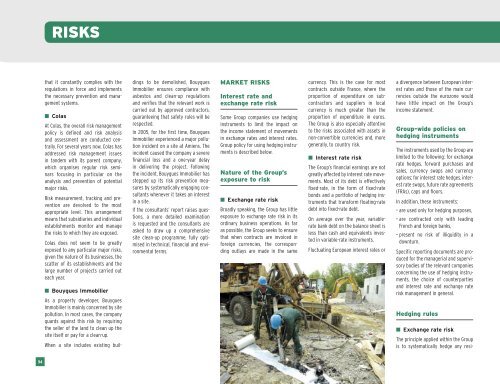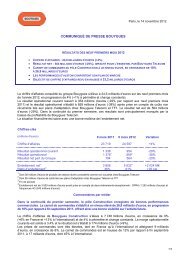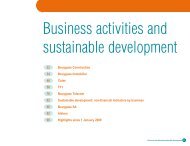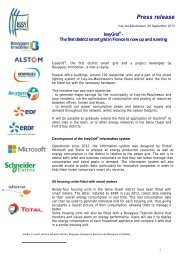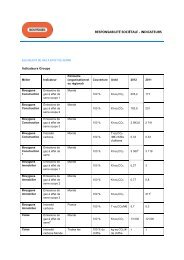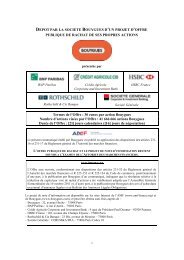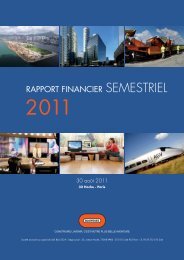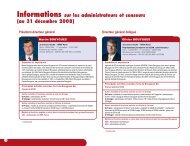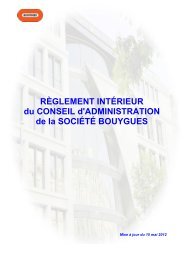A N N U A L R E P O R T - Bouygues
A N N U A L R E P O R T - Bouygues
A N N U A L R E P O R T - Bouygues
You also want an ePaper? Increase the reach of your titles
YUMPU automatically turns print PDFs into web optimized ePapers that Google loves.
RISKS<br />
The principle applied within the Group<br />
is to systematically hedge any resithat<br />
it constantly complies with the<br />
regulations in force and implements<br />
the necessary prevention and management<br />
systems.<br />
■ Colas<br />
At Colas, the overall risk management<br />
policy is defined and risk analysis<br />
and assessment are conducted centrally.<br />
For several years now, Colas has<br />
addressed risk management issues<br />
in tandem with its parent company,<br />
which organises regular risk seminars<br />
focusing in particular on the<br />
analysis and prevention of potential<br />
major risks.<br />
Risk measurement, tracking and prevention<br />
are devolved to the most<br />
appropriate level. This arrangement<br />
means that subsidiaries and individual<br />
establishments monitor and manage<br />
the risks to which they are exposed.<br />
Colas does not seem to be greatly<br />
exposed to any particular major risks,<br />
given the nature of its businesses, the<br />
scatter of its establishments and the<br />
large number of projects carried out<br />
each year.<br />
■ <strong>Bouygues</strong> Immobilier<br />
As a property developer, <strong>Bouygues</strong><br />
Immobilier is mainly concerned by site<br />
pollution. In most cases, the company<br />
guards against this risk by requiring<br />
the seller of the land to clean up the<br />
site itself or pay for a clean-up.<br />
When a site includes existing buildings<br />
to be demolished, <strong>Bouygues</strong><br />
Immobilier ensures compliance with<br />
asbestos and clean-up regulations<br />
and verifies that the relevant work is<br />
carried out by approved contractors,<br />
guaranteeing that safety rules will be<br />
respected.<br />
In 2005, for the first time, <strong>Bouygues</strong><br />
Immobilier experienced a major pollution<br />
incident on a site at Amiens. The<br />
incident caused the company a severe<br />
financial loss and a one-year delay<br />
in delivering the project. Following<br />
the incident, <strong>Bouygues</strong> Immobilier has<br />
stepped up its risk prevention measures<br />
by systematically engaging consultants<br />
whenever it takes an interest<br />
in a site.<br />
If the consultants’ report raises questions,<br />
a more detailed examination<br />
is requested and the consultants are<br />
asked to draw up a comprehensive<br />
site clean-up programme, fully optimised<br />
in technical, financial and environmental<br />
terms.<br />
MARKET RISKS<br />
Interest rate and<br />
exchange rate risk<br />
Some Group companies use hedging<br />
instruments to limit the impact on<br />
the income statement of movements<br />
in exchange rates and interest rates.<br />
Group policy for using hedging instruments<br />
is described below.<br />
Nature of the Group’s<br />
exposure to risk<br />
■ Exchange rate risk<br />
Broadly speaking, the Group has little<br />
exposure to exchange rate risk in its<br />
ordinary business operations. As far<br />
as possible, the Group seeks to ensure<br />
that when contracts are invoiced in<br />
foreign currencies, the corresponding<br />
outlays are made in the same<br />
currency. This is the case for most<br />
contracts outside France, where the<br />
proportion of expenditure on subcontractors<br />
and suppliers in local<br />
currency is much greater than the<br />
proportion of expenditure in euros.<br />
The Group is also especially attentive<br />
to the risks associated with assets in<br />
non-convertible currencies and, more<br />
generally, to country risk.<br />
■ Interest rate risk<br />
The Group’s financial earnings are not<br />
greatly affected by interest rate movements.<br />
Most of its debt is effectively<br />
fixed-rate, in the form of fixed-rate<br />
bonds and a portfolio of hedging instruments<br />
that transform floating-rate<br />
debt into fixed-rate debt.<br />
On average over the year, variablerate<br />
bank debt on the balance sheet is<br />
less than cash and equivalents invested<br />
in variable-rate instruments.<br />
Fluctuating European interest rates or<br />
a divergence between European interest<br />
rates and those of the main currencies<br />
outside the eurozone would<br />
have little impact on the Group’s<br />
income statement.<br />
Group-wide policies on<br />
hedging instruments<br />
The instruments used by the Group are<br />
limited to the following: for exchange<br />
rate hedges, forward purchases and<br />
sales, currency swaps and currency<br />
options; for interest rate hedges, interest<br />
rate swaps, future rate agreements<br />
(FRAs), caps and floors.<br />
In addition, these instruments:<br />
• are used only for hedging purposes,<br />
• are contracted only with leading<br />
French and foreign banks,<br />
• present no risk of illiquidity in a<br />
downturn.<br />
Specific reporting documents are produced<br />
for the managerial and supervisory<br />
bodies of the relevant companies<br />
concerning the use of hedging instruments,<br />
the choice of counterparties<br />
and interest rate and exchange rate<br />
risk management in general.<br />
Hedging rules<br />
■ Exchange rate risk<br />
94


